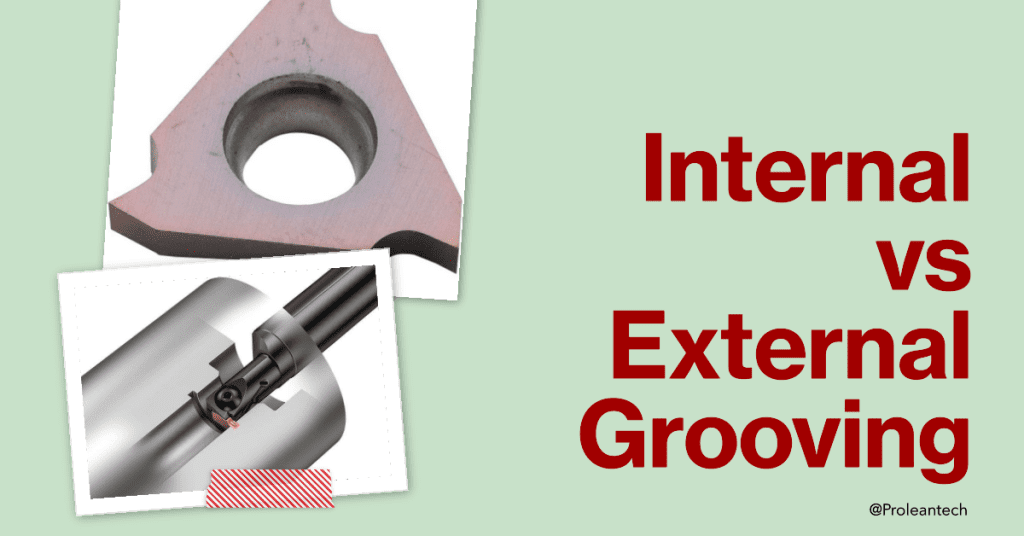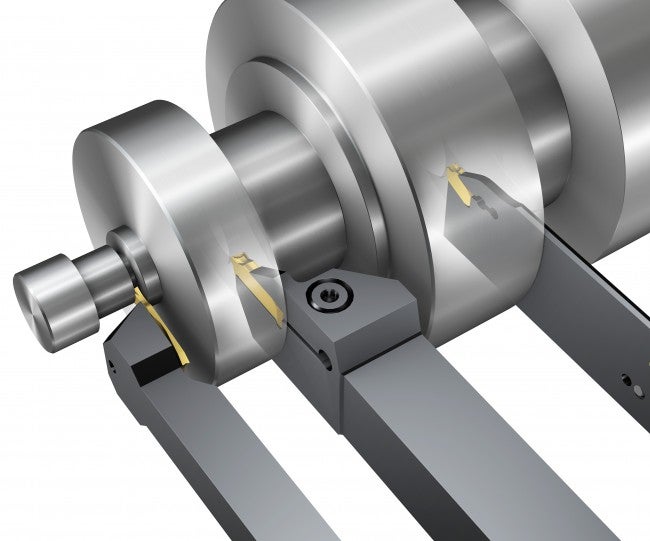The grooving operation involves the removal of material from a workpiece to create specific grooves. The process can be applied in various ways, primarily categorized as internal and external grooving.

Understanding these two types of grooving— their similarities, differences, applications, and challenges— is crucial in determining the right method for a specific project. This article delves into the fascinating world of grooving, providing a detailed comparison of internal and external grooving processes.
What is Internal Grooving?

Internal grooving
Internal grooving is a precise machining process that involves creating grooves within the internal diameter or bore of a workpiece. Unlike external grooving, which deals with the outer surface of the workpiece, internal grooving works within the material’s inner space. This process requires specialized tools and setups to access the limited space and ensure precise and accurate groove formation.
Process of Internal Grooving
The process of internal grooving begins with the selection of a suitable tool designed for inner diameter operations. These tools, often made of high-speed steel (HSS) or carbide, are typically mounted on a lathe or a CNC machine. The machine then drives the tool into the workpiece along a predetermined path to create the desired groove. The process is guided by a CNC program that controls the tool’s movement, depth of cut, and speed to ensure high precision and accuracy.
Steps Involved in Internal Grooving
- Tool Selection: A grooving tool suitable for internal operations is chosen based on the groove dimensions and workpiece material.
- Machine Setup: The tool is mounted onto the machine, and the workpiece is secured in the chuck.
- CNC Programming: The groove’s specifications are programmed into the CNC machine.
- Machining: The machine drives the tool into the workpiece to form the groove. The operation might be repeated for multiple grooves or deeper cuts.
- Inspection: The grooved workpiece is inspected to ensure it meets the required specifications.
Applications of Internal Grooving
Internal grooving finds its application in a variety of industries and manufacturing processes where features within the internal diameter of a part are required.
1 Creating Internal Features
Internal grooving is often used to create internal features such as undercuts, keyways, or recesses within the bore of a part. These features can serve functional purposes in various components, such as facilitating the attachment of other parts or allowing for the passage of fluids or gases.
2 Manufacturing of Hydraulic Components
In the hydraulic industry, internal grooving plays a significant role in the manufacturing of components like pistons and cylinders. The grooves hold the seals and rings that ensure the proper functioning of these components.
Read more: Grooving in Manufacturing Hydraulic Components
Benefits of Internal Grooving
Internal grooving offers several benefits that make it a valuable process in machining operations.
With the right tools and CNC control, internal grooving allows for high precision in creating intricate features within a workpiece. Furthermore. It from simple linear grooves to complex undercut profiles, internal grooving can handle a wide range of applications, making it a versatile machining process.
Challenges in Internal Grooving
Despite its benefits, internal grooving presents a few challenges that manufacturers need to address.
- Accessibility: The limited access to the internal diameter of a workpiece can make tool setup and groove inspection more challenging. Specialized tools and inspection devices may be required.
- Heat Management: Heat generated during the internal grooving process can be harder to manage due to the enclosed nature of the operation. Adequate coolant application is crucial to prevent tool wear and thermal deformation of the workpiece.
Table 1: Summary of Internal Grooving
| Aspect | Description |
|---|---|
| Process | Involves creating grooves within the internal diameter of a workpiece |
| Applications | Used to create internal features and in the manufacturing of hydraulic components |
| Benefits | Offers high precision and versatility |
| Challenges | Includes limited accessibility and heat management |
What is External Grooving?

External grooving is a precision machining process that involves creating grooves on the external surface or outer diameter of a workpiece. It differs from internal grooving, which focuses on the inner diameter of the material. External grooving requires specific tools and setups to ensure accurate groove formation on the workpiece’s outer surface.
Process of External Grooving
The process of external grooving begins with the selection of a suitable tool designed for outer diameter operations. These tools, often made of high-speed steel (HSS) or carbide, are typically mounted on a lathe or a CNC machine. The machine then drives the tool along the workpiece’s outer surface along a predetermined path to create the desired groove. The process is guided by a CNC program that controls the tool’s movement, depth of cut, and speed to ensure high precision and accuracy.
Steps Involved in External Grooving
- Tool Selection: A grooving tool suitable for external operations is chosen based on the groove dimensions and workpiece material.
- Machine Setup: The tool is mounted onto the machine, and the workpiece is secured in the chuck.
- CNC Programming: The groove’s specifications are programmed into the CNC machine.
- Machining: The machine drives the tool along the workpiece’s outer surface to form the groove. The operation might be repeated for multiple grooves or deeper cuts.
- Inspection: The grooved workpiece is inspected to ensure it meets the required specifications.
Applications of External Grooving
External grooving finds its application in various industries and manufacturing processes where features on the external diameter of a part are required.
1 Creating External Features
External grooving is often used to create external features such as undercuts, keyways, or recesses on a part’s outer surface. These features can serve functional purposes in various components, such as facilitating the attachment of other parts or enhancing the part’s overall strength.
2 Manufacturing of Gears and Splines
In the mechanical industry, external grooving plays a significant role in the manufacturing of components like gears and splines. The grooves provide the necessary engagement between different parts, allowing for power transmission or rotational movement.
3 Benefits of External Grooving
External grooving offers several benefits that make it a valuable process in machining operations.
4 Precision
With the right tools and CNC control, external grooving allows for high precision in creating intricate features on a workpiece’s outer surface.
5 Versatility
From simple linear grooves to complex undercut profiles, external grooving can handle a wide range of applications, making it a versatile machining process.
Challenges in External Grooving
Despite its benefits, external grooving presents a few challenges that manufacturers need to address. As the grooving tool is subjected to continuous contact with the workpiece’s outer surface, tool wear can be a concern. Proper tool selection and appropriate cutting parameters are crucial for maximizing tool life.
Table 1: Summary of External Grooving
| Features | External Grooving |
|---|---|
| Definition | A precision machining process that creates grooves on the outer surface of a workpiece |
| Tool Selection | Tools suitable for external operations, typically made of HSS or carbide |
| Process | Selection of tool, machine setup, CNC programming, machining, and inspection |
| Applications | Creation of external features, manufacturing of gears and splines |
| Benefits | High precision, versatility |
| Challenges | Tool wear, achieving high-quality surface finish |
Key Factors for Successful Grooving Operations
Grooving operations, whether internal or external, require precision and careful execution to ensure success. Several key factors influence the results of these machining processes. By understanding and controlling these factors, manufacturers can enhance the accuracy, efficiency, and overall quality of their grooving operations.
- Tool Selection: Choose the appropriate tool material and geometry for the job.
- Cutting Parameters: Optimize the cutting speed, feed rate, and depth of cut for the best balance between machining efficiency, tool life, and groove quality.
- Workpiece Material: Consider the properties of the workpiece material when selecting the tool and setting the cutting parameters.
- Coolant Use: Use coolants where necessary to reduce heat and friction, but consider their impact on operation complexity and cost.
Conclusion
Grooving operations play an essential role, and understanding the differences between internal and external grooving can aid in selecting the right method for a given task. While both techniques have their unique strengths and applications, they also present their own sets of challenges.
In the end, the success of a grooving operation doesn’t merely rely on the choice of the right grooving type & tools but also on the skill and expertise of the operator. By combining knowledge with experience, you can significantly enhance your operations’ efficiency and quality. To ensure optimal results, consider partnering with industry leaders like Prolean’s Grooving Machining Service, renowned for delivering unparalleled quality and precision.
FAQ’s
What is the main difference between internal and external grooving?
Internal grooving involves the creation of grooves within the interior of a workpiece, while external grooving refers to the process of forming grooves on the outer surface of the piece.
Which one is more challenging: internal or external grooving?
Internal grooving can be more challenging due to the limited space and visibility. It often requires specialized tools and careful planning.
Can the same tools be used for internal and external grooving?
While some tools can perform both operations, specific internal and external grooving tools are designed to handle the unique challenges of each process.
How important is tool selection in grooving operations?
Tool selection is critical in grooving operations. The chosen tool must be suitable for the material of the workpiece and capable of producing the desired groove type, width, and depth.
What factors are crucial for successful grooving operations?
Key factors include tool selection, proper tool positioning, correct cutting parameters, effective chip control, and the use of appropriate coolant when necessary.




0 Comments